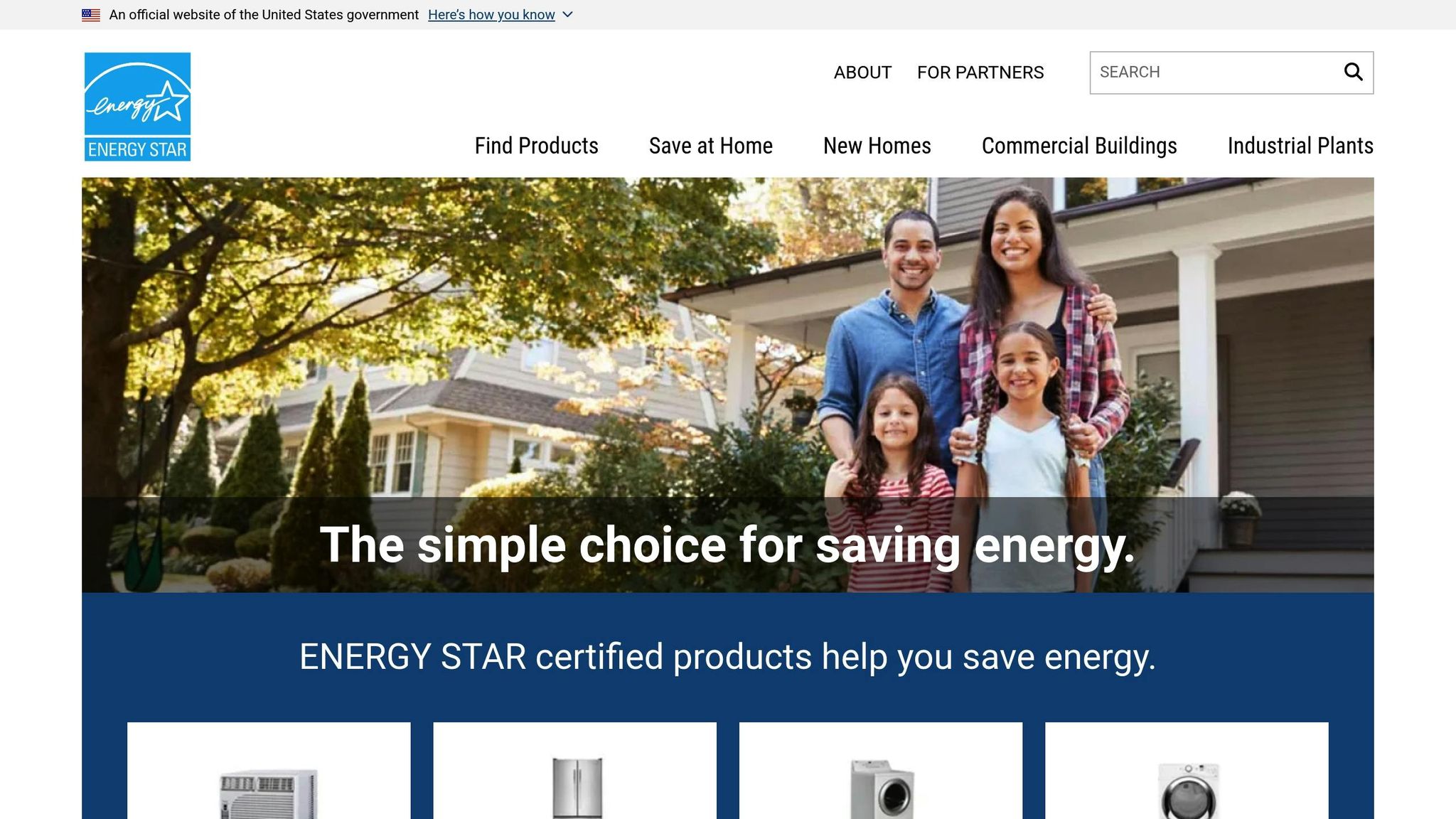Want to save money on your home while reducing energy use? Green mortgages might be the answer. These loans let you finance energy-efficient home upgrades – like better insulation, solar panels, or modern windows – by rolling the costs into your mortgage. Here’s what you need to know:
- Lower Energy Bills: Upgrades can cut heating and cooling costs by up to 70%.
- Easy Financing: Costs are added to your mortgage, so there’s no large upfront payment.
- Government Programs: FHA, VA, and other lenders offer options with low credit score requirements.
- Tax Perks: You may qualify for tax credits and rebates.
Green mortgages are simple to qualify for if you already meet standard loan criteria. The process starts with a Home Energy Rating System (HERS) evaluation to identify cost-effective improvements. These upgrades not only save money but can also increase your home’s value.
Ready to go green? Start by gathering your utility bills, scheduling a home energy assessment, and exploring mortgage options with your lender.
Green Mortgage Fundamentals
Available Loan Programs
Several major lenders provide energy-efficient mortgage programs designed to make eco-friendly home upgrades more accessible.
The Federal Housing Administration (FHA) Energy Efficient Mortgage allows financing for energy improvements up to 5% of the home’s appraised value. The loan limit is set at either 115% of the area’s median home price or 150% of the local Freddie Mac conforming limit, whichever is lower [2].
For veterans and active military members, the VA Energy Efficient Mortgage offers up to $6,000 for energy upgrades if the projected savings exceed the additional mortgage payment – or $3,000 based solely on documented costs [2].
Fannie Mae and Freddie Mac also provide conventional green loan options:
- Fannie Mae: Financing up to 15% of the home’s post-improvement value.
- Freddie Mac GreenCHOICE Mortgage: Covers energy-efficient upgrades, including solar water heaters, with the same 15% cap [2].
Qualification Requirements
Qualifying for an energy-efficient mortgage (EEM) is similar to applying for a standard mortgage. As noted, "If you qualify for a regular mortgage, in most cases, you already qualify for an EEM" [2].
Here’s what lenders typically look for:
| Program Type | Minimum Credit Score | Down Payment Required |
|---|---|---|
| Conventional | 620 | 3% |
| FHA | 580 | 3.5% |
| VA | 620 | Varies |
| GreenCHOICE | 660 | 3% |
Another key requirement is a Home Energy Rating System (HERS) evaluation, which costs between $300 and $800. This evaluation, which can be financed through your loan, identifies the most cost-effective energy improvements [2].
Loan Perks and Rewards
Green mortgages provide several advantages compared to traditional loans. One standout benefit is the ability to fund energy upgrades at the same interest rate as your primary mortgage, avoiding the higher rates often tied to separate home improvement loans [2].
Additional benefits include:
- Higher Borrowing Potential: Lenders may approve a higher debt-to-income ratio due to expected utility savings.
- Simplified Payments: Energy upgrade costs are folded into your main mortgage payment.
- Cost Efficiency: Improvements must prove that their total cost is less than the lifetime energy savings [2].
"With an energy-efficient mortgage, homebuyers can finance these types of improvements on better terms." – Kevin Kane, Chief Economist with Green Homeowners United [1]
Combined with tax credits and rebates from the Inflation Reduction Act, these mortgages offer even greater savings and increase the value of energy-efficient homes [1].
Cost Savings and Returns
Lower Energy Bills
Upgrading your home with energy-efficient features through green mortgages can lead to noticeable savings on utility bills. Heating and cooling typically make up 50–70% of the energy used in an average U.S. home [2]. Adding insulation can trim those costs by up to 20%. Installing modern double-paned windows can cut energy loss by about 24% during winter and 18% in warmer climates. On top of that, programmable thermostats can save you around $180 annually [2]. These upgrades not only reduce monthly expenses but also come with tax perks and incentives.
Tax Credits and Incentives
Government programs offer tax credits and rebates to help cover the cost of energy-efficient home improvements, making green mortgages even more appealing. To tap into these benefits, start by scheduling a Home Energy Rating System (HERS) evaluation to pinpoint the most impactful upgrades. Keep detailed records of all qualifying improvements, and ensure installations are professionally inspected and verified. This documentation is crucial when applying for any available credits or rebates.
Increased Home Value
In addition to saving on utilities and benefiting from tax incentives, energy-efficient upgrades can make your home more appealing to buyers and potentially increase its market value. Features like updated windows, better insulation, and smart climate control systems reduce operating costs and attract eco-conscious buyers. Homes with documented energy efficiency improvements often stand out in the real estate market, giving them a competitive edge and the potential to fetch higher prices.
Green Home Financing 101: Lenders, Loans, and Incentives …
sbb-itb-8115fc4
Qualifying Home Improvements
Using a green mortgage to fund energy-efficient upgrades can lower utility bills and help reduce your environmental impact. Here are some upgrades that can make a big difference in energy efficiency and long-term savings.
Solar Power Systems
Installing solar panels is one of the most impactful energy upgrades you can make with a green mortgage. These systems can cut electricity costs significantly, boost your property value, and support eco-friendly living. While the initial installation can be pricey, financing it through a green mortgage makes it more affordable for many homeowners [1].
ENERGY STAR Appliances
ENERGY STAR-certified appliances are designed to save both energy and money. For example, ENERGY STAR dishwashers can save up to 1,200 gallons of water each year. Upgrading to high-efficiency HVAC systems can also lower energy use for heating and cooling, which typically accounts for 50–70% of a home’s energy consumption. Tankless water heaters are another smart choice, providing hot water on demand while using less energy. To qualify, these upgrades must show that their total cost is less than the estimated energy savings over their lifetime [2].
Home Automation Systems
Smart home devices help you take control of your energy use. For instance, programmable thermostats can reduce heating bills by about 2% and cooling bills by over 3%, potentially saving you up to $180 annually. Advanced automation systems can also tackle issues like duct leakage, further cutting down on energy waste. Keep in mind that approved upgrades must be completed within 90–180 days while the funds are held in escrow [2].
Not only do these upgrades help lower your utility bills, but they also add value to your home – all under one manageable loan.
Steps to Success
Home Energy Assessment
The first step toward financing energy upgrades is getting a professional home energy assessment. During this process, a certified energy rater uses tools like infrared cameras and blower door tests to find air leaks and insulation gaps.
"Before performing any insulation and air sealing improvements or upgrading HVAC systems, have a professional infrared/blower door energy audit performed", says Flemming Lund from Infrared Diagnostic [3].
This assessment evaluates:
- Air leaks in windows, doors, outlets, and plumbing penetrations
- Insulation levels in the attic, walls, and basement
- HVAC system performance and the condition of ductwork
- Energy efficiency ratings of appliances
Once the assessment is complete, you can look into financial incentives to make the most of your green mortgage benefits.
Finding Available Incentives
After your energy assessment, identifying financial incentives can help you save more. Federal agencies like FHA, VA, Fannie Mae, and Freddie Mac, along with state programs, offer various benefits for energy-efficient improvements.
Here’s how to secure these incentives:
- Use your HERS evaluation results to qualify for specific programs.
- Research local incentives through the National Association of State Energy Officials website.
- Submit applications before program deadlines to ensure eligibility.
Professional Guidance
"When retrofitting a home or building, you have to save energy first, before you make or generate energy", advises Green Energy Money [3].
Working with qualified professionals ensures your green mortgage investments deliver the best results. Your HERS report can guide you in prioritizing improvements and finding certified contractors who specialize in energy-efficient upgrades.
"Heating and cooling your home is 50% of your utility bill annually", explains Ryan Stewart from Stewart Heating, Plumbing and Air Conditioning [3].
Upgrades must be completed within 90-180 days, as funds stay in escrow until a final inspection confirms everything is up to standard. Choose contractors familiar with these requirements who can also provide the necessary documentation for approval.
Next Steps
Before diving into the green mortgage process, make sure you’re fully prepared with these steps:
Getting started:
- Gather your recent utility bills to understand your current energy costs.
- Schedule a professional home energy assessment.
- Use the HERS report to create a list of priority upgrades.
- Estimate your potential monthly savings from planned improvements.
- Obtain contractor estimates for the upgrades you’re considering.
Key documents to have ready:
- Your current mortgage statement (if refinancing).
- Property tax records.
- Home insurance policy details.
- Proof of income.
- Results from your energy assessment.
- Contractor proposals for the planned upgrades.
Having everything organized ahead of time will make the process smoother. Keep in mind, many green mortgage programs require all upgrades to be completed within 180 days of closing. Work closely with your lender to create a timeline that factors in contractor availability and any seasonal challenges.
Ready to move forward? Contact our team of mortgage professionals to explore green mortgage options tailored to your goals. From the initial assessment to final approval, we’ll guide you every step of the way.
Related posts








